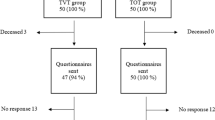Abstract
Introduction and hypothesis
The objective of this study is to compare the efficacy and safety of tension-free vaginal tape (TVT) with Marshall–Marchetti–Krantz (MMK) procedure in stress urinary incontinence (SUI) treatment.
Methods
Two hundred twenty-eight patients were enrolled in this study. TVT procedure was performed in 105 cases, MMK procedure was performed in 81 cases, Chi-square test was used, and P < 0.01 was considered statistically significant.
Results
The short-term success rate was about 89% in MMK group. However, the success rate fell to 68.2% at 5 years and 32% at 10 years. The short-term cure rate of TVT procedure was about 90.0%, and the 5-year cure rate was 84.3%.
Conclusions
The short-term cure rate in both groups was similar, but the long-term success rate of the MMK procedure decreased sharply with time. The TVT technique provides long-term cure rates of over 84% with minimal complications. Patients who underwent TVT experienced shorter operation time, less blood loss, and less hospital stay.

Similar content being viewed by others
Abbreviations
- FUL:
-
Functional urethral length
- MMK procedure:
-
Marshall–Marchetti–Krantz procedure
- Qmax:
-
Maximal urinary flow rate
- MUCP:
-
Maximal urethral closure pressure
- SUI:
-
Stress urinary incontinence
- TVT:
-
Tension-free vaginal tape
References
Hunskaar S, Burgio K, Clark A (2005) Epidemiology of urinary and faecal incontinence and pelvic organ prolapsed. In: Abrams P, Cardozo L, Khoury S, Wein A (eds) Incontinence: 3rd international consultation on incontinence. Health Publications, Plymouth, UK, pp 255–312
Waetjen LE, Subak LL, Shen H, Lin F, Wang TH, Vittinghoff E et al (2003) Stress urinary incontinence surgery in the United States. Obstet Gynecol 101:671–676
Boyles SH, Weber AM, Meyn L (2003) Procedures for pelvic organ prolapse in the United States 1979–97. Am J Obstet Gynecol 188:108–115
Luber KM, Boero S, Choe JY (2001) The demographics of pelvic floor disorders: current observations and future projections. Am J Obstet Gynecol 184:1496–1503
Petros P, Ulmsten U (1993) An integral theory and its method for the diagnosis and management of female urinary incontinence. Scand J Urol Nephrol 153:1–93
Mainprize TC, Drutz HP (1988) The Marshall-Marchetti-Krantz procedure: a critical review. Obstet Gynecol Surv 43:724–729
Lee RA, Symmonds RE, Goldstein RA (1979) Surgical complications and results of modified Marshall-Marchetti-Krantz procedure for urinary incontinence. Am J Obstet Gynecol 53:447–450
Jarvis GJ (1994) Surgery for genuine stress incontinence. BJOG 101:371–374
Czaplicki M, Dobronski P, Torz C, Borkowski A (1998) Long-term subjective results of Marshall-Marchetti-Krantz procedure. Eur Urol 34:118–123
Clemens JQ, Stern JA, Bushman WA, Schaeffer AJ (1998) Long term results of the Stamey bladder neck suspension: direct comparison with the Marshall-Marchetti-Krantz procedure. J Urol 160:372–376
Colombo M, Scalambrino S, Maggioni A, Milani R (1994) Burch colposuspension versus modified Marshall-Marchetti-Krantz urethropexy for primary genuine stress urinary incontinence: a prospective, randomized trial. Am J Obstet Gynecol 171:1573–1579
Nilsson CG (2004) Introduction of a new surgical procedure for treatment of female urinary incontinence. Acta Obstet Gynecol Scand 83:877–880
Merlin T, Arnold E, Petros P, MacTaggart P, Tulloch A, Faulkner K et al (2001) A systematic review of tension-free urethropexy for stress urinary incontinence: intravaginal slingplasty and the tension-free vaginal tape procedures. BJU Int 88:871–880
Petros P, Ulmsten U (1995) Intravaginal slingplasty: an ambulatory surgical procedure for treatment of female urinary incontinence. Scand J Urol Nephrol 29:1–75
Nilsson CG, Kuuva N, Falconer C, Rezapour M, Ulmsten U (2001) Longterm results of the tension-free vaginal tape (TVT) procedure for surgical treatment of female stress urinary incontinence. Int Urogynecol J Pelvic Floor Dysfunct 12(suppl 2):S5–S8
Atherton MJ, Stanton SL (2005) The tension-free vaginal tape reviewed: an evidence based review from inception to current status. BJOG 112:534–546
Lo TS (2004) Tension-free vaginal tape procedures in women with stress urinary incontinence with and without co-existing genital prolapsed. Curr Opin Obstet Gynecol 16:399–404
Acknowledgement
The authors thank Professor Zhou-jun Shen for providing technical assistance.
Conflicts of interest
None.
Author information
Authors and Affiliations
Corresponding author
Additional information
**-Yan Wu and Hong-Chao He are co-first authors.
Rights and permissions
About this article
Cite this article
Wu, JY., He, HC., Chen, SW. et al. Surgical therapies of female stress urinary incontinence: experience in 228 cases. Int Urogynecol J 21, 645–649 (2010). https://doi.org/10.1007/s00192-009-1093-5
Received:
Accepted:
Published:
Issue Date:
DOI: https://doi.org/10.1007/s00192-009-1093-5



